Recent changes and impact on roles and responsibilities of RN
VerifiedAdded on 2023/04/21
|10
|2719
|468
AI Summary
This document discusses the recent changes in the nursing profession and their impact on the roles and responsibilities of registered nurses. It explores the evolving healthcare system and the expanding roles of RNs in providing patient-centered care. The document also highlights the role of the Nursing and Midwifery Council as a professional body for nurses and the code of nursing practice that sets the standards for nursing professionals. Additionally, it discusses the importance of effective communication in multidisciplinary healthcare settings and the role of RNs in such settings.
Contribute Materials
Your contribution can guide someone’s learning journey. Share your
documents today.
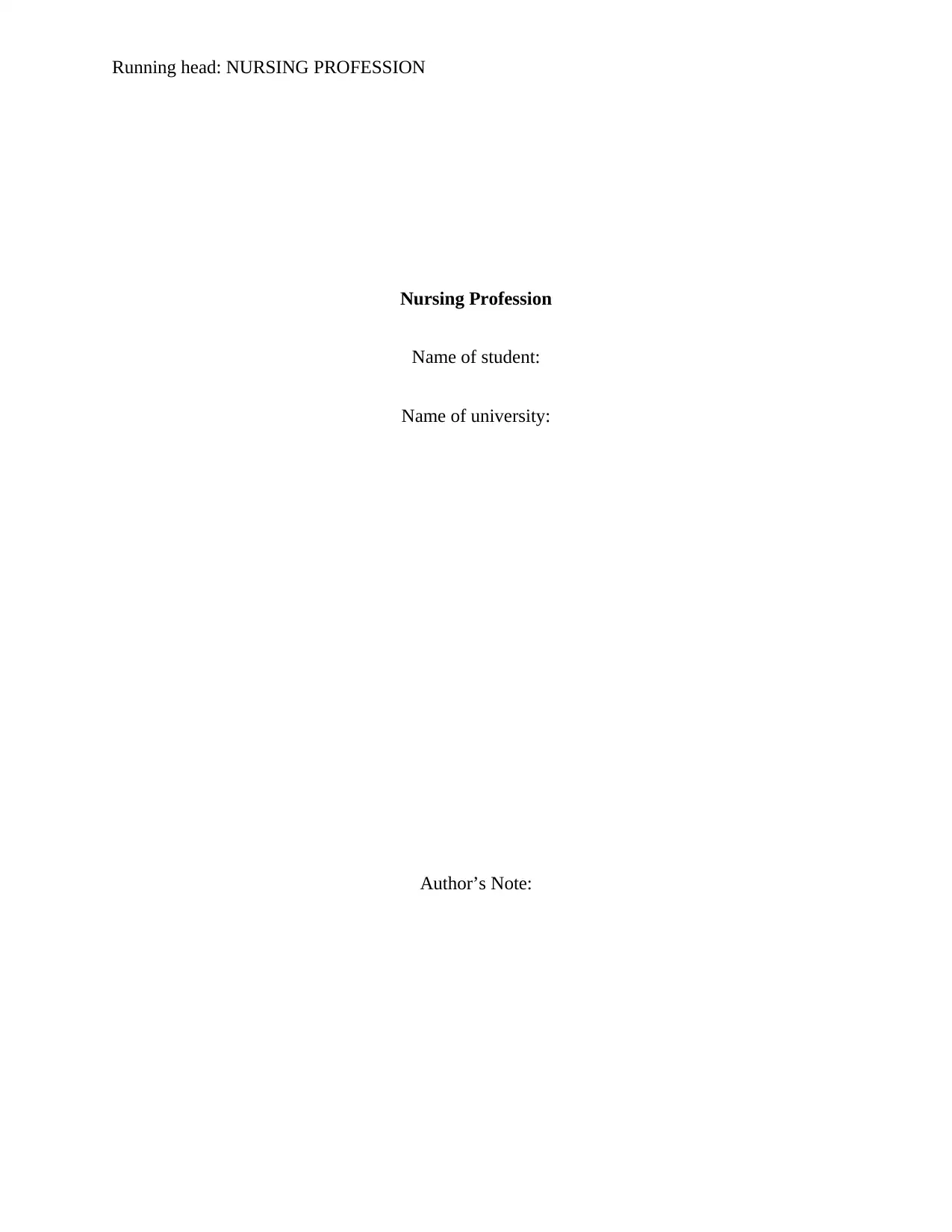
Running head: NURSING PROFESSION
Nursing Profession
Name of student:
Name of university:
Author’s Note:
Nursing Profession
Name of student:
Name of university:
Author’s Note:
Secure Best Marks with AI Grader
Need help grading? Try our AI Grader for instant feedback on your assignments.
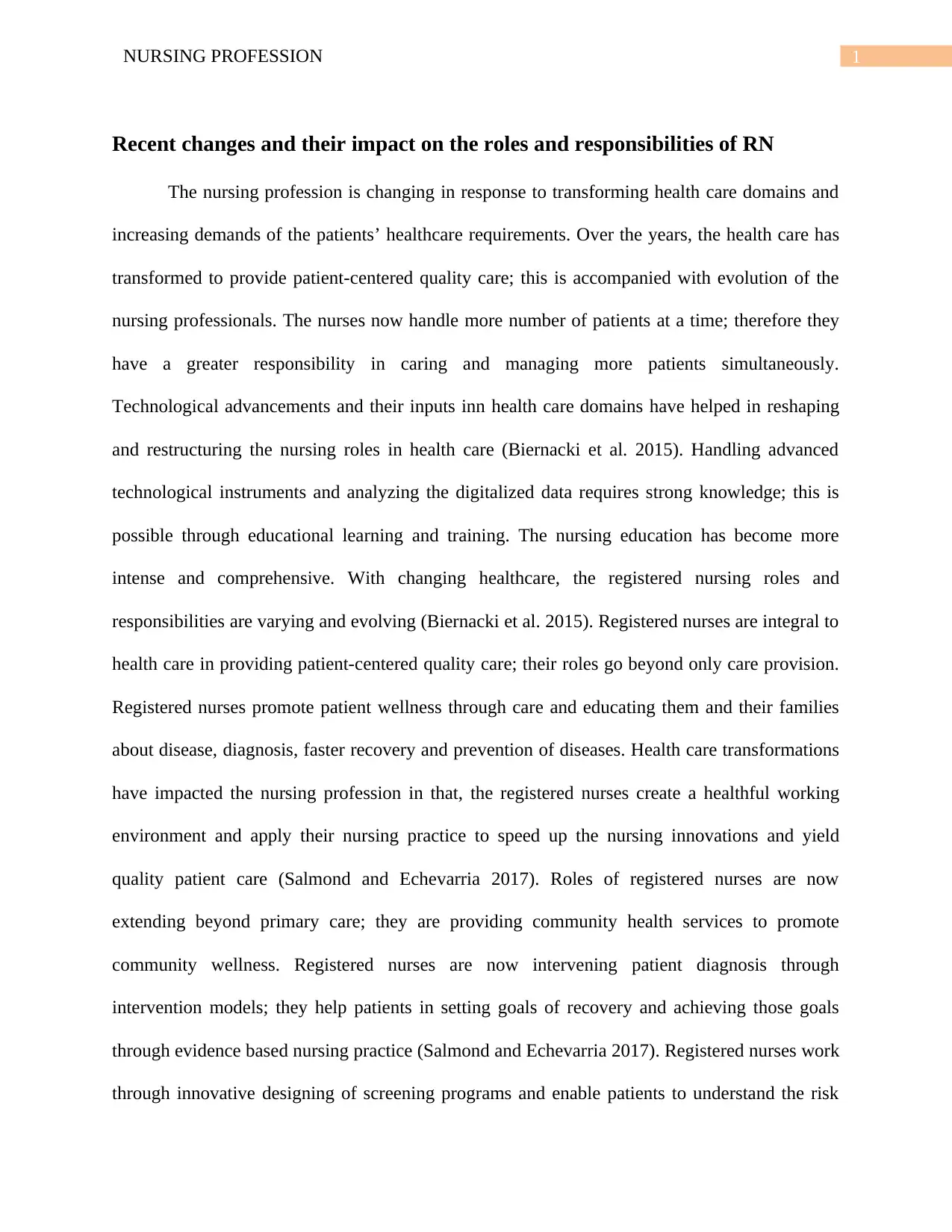
1NURSING PROFESSION
Recent changes and their impact on the roles and responsibilities of RN
The nursing profession is changing in response to transforming health care domains and
increasing demands of the patients’ healthcare requirements. Over the years, the health care has
transformed to provide patient-centered quality care; this is accompanied with evolution of the
nursing professionals. The nurses now handle more number of patients at a time; therefore they
have a greater responsibility in caring and managing more patients simultaneously.
Technological advancements and their inputs inn health care domains have helped in reshaping
and restructuring the nursing roles in health care (Biernacki et al. 2015). Handling advanced
technological instruments and analyzing the digitalized data requires strong knowledge; this is
possible through educational learning and training. The nursing education has become more
intense and comprehensive. With changing healthcare, the registered nursing roles and
responsibilities are varying and evolving (Biernacki et al. 2015). Registered nurses are integral to
health care in providing patient-centered quality care; their roles go beyond only care provision.
Registered nurses promote patient wellness through care and educating them and their families
about disease, diagnosis, faster recovery and prevention of diseases. Health care transformations
have impacted the nursing profession in that, the registered nurses create a healthful working
environment and apply their nursing practice to speed up the nursing innovations and yield
quality patient care (Salmond and Echevarria 2017). Roles of registered nurses are now
extending beyond primary care; they are providing community health services to promote
community wellness. Registered nurses are now intervening patient diagnosis through
intervention models; they help patients in setting goals of recovery and achieving those goals
through evidence based nursing practice (Salmond and Echevarria 2017). Registered nurses work
through innovative designing of screening programs and enable patients to understand the risk
Recent changes and their impact on the roles and responsibilities of RN
The nursing profession is changing in response to transforming health care domains and
increasing demands of the patients’ healthcare requirements. Over the years, the health care has
transformed to provide patient-centered quality care; this is accompanied with evolution of the
nursing professionals. The nurses now handle more number of patients at a time; therefore they
have a greater responsibility in caring and managing more patients simultaneously.
Technological advancements and their inputs inn health care domains have helped in reshaping
and restructuring the nursing roles in health care (Biernacki et al. 2015). Handling advanced
technological instruments and analyzing the digitalized data requires strong knowledge; this is
possible through educational learning and training. The nursing education has become more
intense and comprehensive. With changing healthcare, the registered nursing roles and
responsibilities are varying and evolving (Biernacki et al. 2015). Registered nurses are integral to
health care in providing patient-centered quality care; their roles go beyond only care provision.
Registered nurses promote patient wellness through care and educating them and their families
about disease, diagnosis, faster recovery and prevention of diseases. Health care transformations
have impacted the nursing profession in that, the registered nurses create a healthful working
environment and apply their nursing practice to speed up the nursing innovations and yield
quality patient care (Salmond and Echevarria 2017). Roles of registered nurses are now
extending beyond primary care; they are providing community health services to promote
community wellness. Registered nurses are now intervening patient diagnosis through
intervention models; they help patients in setting goals of recovery and achieving those goals
through evidence based nursing practice (Salmond and Echevarria 2017). Registered nurses work
through innovative designing of screening programs and enable patients to understand the risk
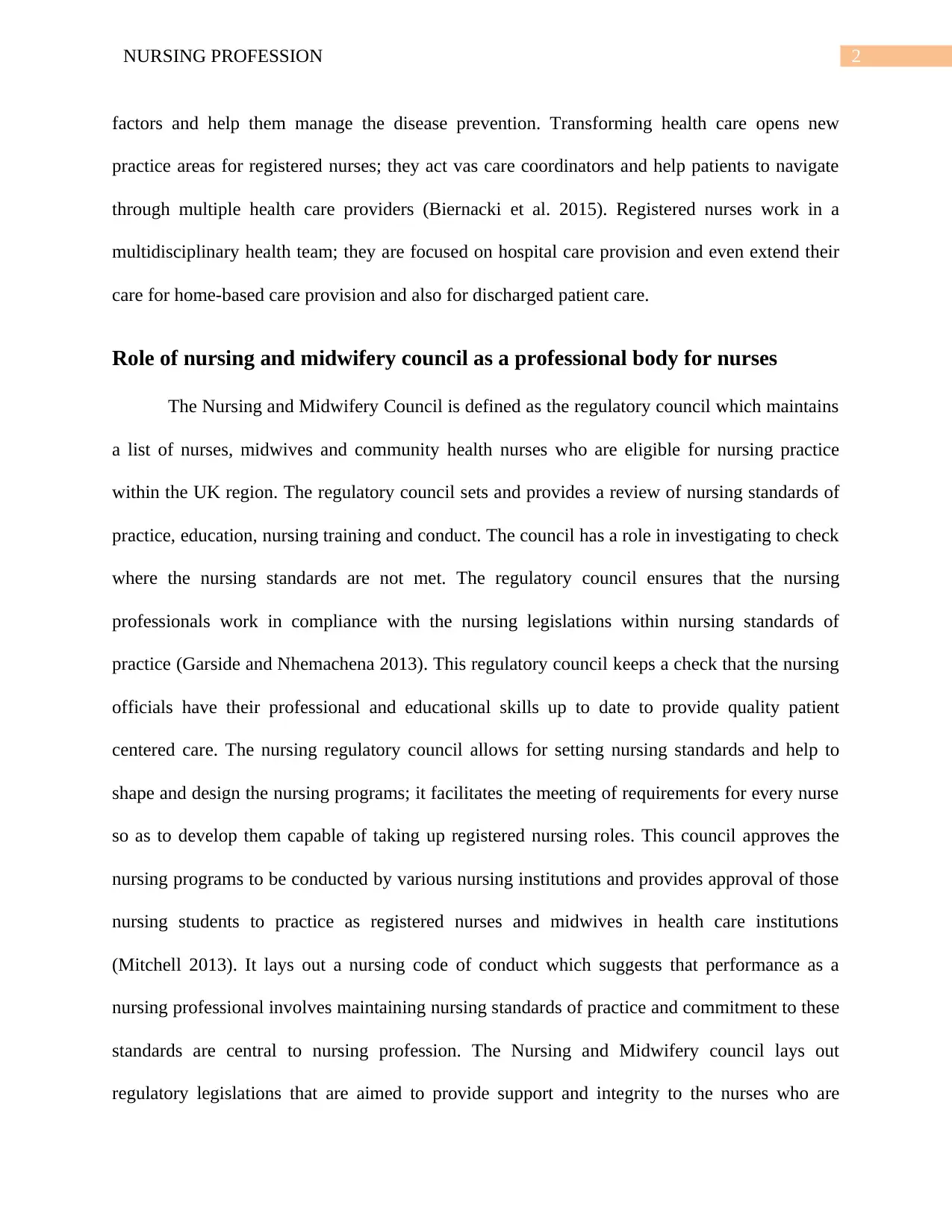
2NURSING PROFESSION
factors and help them manage the disease prevention. Transforming health care opens new
practice areas for registered nurses; they act vas care coordinators and help patients to navigate
through multiple health care providers (Biernacki et al. 2015). Registered nurses work in a
multidisciplinary health team; they are focused on hospital care provision and even extend their
care for home-based care provision and also for discharged patient care.
Role of nursing and midwifery council as a professional body for nurses
The Nursing and Midwifery Council is defined as the regulatory council which maintains
a list of nurses, midwives and community health nurses who are eligible for nursing practice
within the UK region. The regulatory council sets and provides a review of nursing standards of
practice, education, nursing training and conduct. The council has a role in investigating to check
where the nursing standards are not met. The regulatory council ensures that the nursing
professionals work in compliance with the nursing legislations within nursing standards of
practice (Garside and Nhemachena 2013). This regulatory council keeps a check that the nursing
officials have their professional and educational skills up to date to provide quality patient
centered care. The nursing regulatory council allows for setting nursing standards and help to
shape and design the nursing programs; it facilitates the meeting of requirements for every nurse
so as to develop them capable of taking up registered nursing roles. This council approves the
nursing programs to be conducted by various nursing institutions and provides approval of those
nursing students to practice as registered nurses and midwives in health care institutions
(Mitchell 2013). It lays out a nursing code of conduct which suggests that performance as a
nursing professional involves maintaining nursing standards of practice and commitment to these
standards are central to nursing profession. The Nursing and Midwifery council lays out
regulatory legislations that are aimed to provide support and integrity to the nurses who are
factors and help them manage the disease prevention. Transforming health care opens new
practice areas for registered nurses; they act vas care coordinators and help patients to navigate
through multiple health care providers (Biernacki et al. 2015). Registered nurses work in a
multidisciplinary health team; they are focused on hospital care provision and even extend their
care for home-based care provision and also for discharged patient care.
Role of nursing and midwifery council as a professional body for nurses
The Nursing and Midwifery Council is defined as the regulatory council which maintains
a list of nurses, midwives and community health nurses who are eligible for nursing practice
within the UK region. The regulatory council sets and provides a review of nursing standards of
practice, education, nursing training and conduct. The council has a role in investigating to check
where the nursing standards are not met. The regulatory council ensures that the nursing
professionals work in compliance with the nursing legislations within nursing standards of
practice (Garside and Nhemachena 2013). This regulatory council keeps a check that the nursing
officials have their professional and educational skills up to date to provide quality patient
centered care. The nursing regulatory council allows for setting nursing standards and help to
shape and design the nursing programs; it facilitates the meeting of requirements for every nurse
so as to develop them capable of taking up registered nursing roles. This council approves the
nursing programs to be conducted by various nursing institutions and provides approval of those
nursing students to practice as registered nurses and midwives in health care institutions
(Mitchell 2013). It lays out a nursing code of conduct which suggests that performance as a
nursing professional involves maintaining nursing standards of practice and commitment to these
standards are central to nursing profession. The Nursing and Midwifery council lays out
regulatory legislations that are aimed to provide support and integrity to the nurses who are
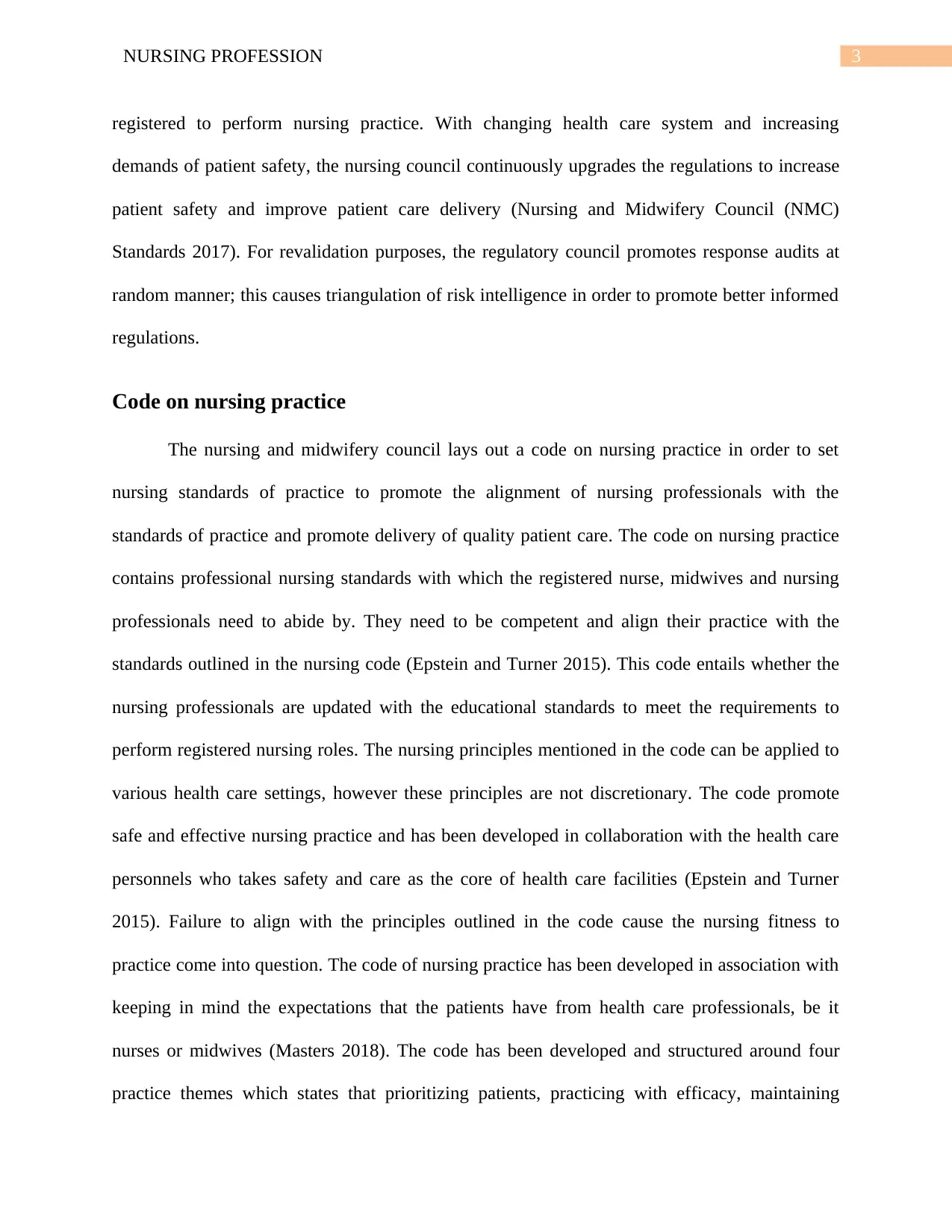
3NURSING PROFESSION
registered to perform nursing practice. With changing health care system and increasing
demands of patient safety, the nursing council continuously upgrades the regulations to increase
patient safety and improve patient care delivery (Nursing and Midwifery Council (NMC)
Standards 2017). For revalidation purposes, the regulatory council promotes response audits at
random manner; this causes triangulation of risk intelligence in order to promote better informed
regulations.
Code on nursing practice
The nursing and midwifery council lays out a code on nursing practice in order to set
nursing standards of practice to promote the alignment of nursing professionals with the
standards of practice and promote delivery of quality patient care. The code on nursing practice
contains professional nursing standards with which the registered nurse, midwives and nursing
professionals need to abide by. They need to be competent and align their practice with the
standards outlined in the nursing code (Epstein and Turner 2015). This code entails whether the
nursing professionals are updated with the educational standards to meet the requirements to
perform registered nursing roles. The nursing principles mentioned in the code can be applied to
various health care settings, however these principles are not discretionary. The code promote
safe and effective nursing practice and has been developed in collaboration with the health care
personnels who takes safety and care as the core of health care facilities (Epstein and Turner
2015). Failure to align with the principles outlined in the code cause the nursing fitness to
practice come into question. The code of nursing practice has been developed in association with
keeping in mind the expectations that the patients have from health care professionals, be it
nurses or midwives (Masters 2018). The code has been developed and structured around four
practice themes which states that prioritizing patients, practicing with efficacy, maintaining
registered to perform nursing practice. With changing health care system and increasing
demands of patient safety, the nursing council continuously upgrades the regulations to increase
patient safety and improve patient care delivery (Nursing and Midwifery Council (NMC)
Standards 2017). For revalidation purposes, the regulatory council promotes response audits at
random manner; this causes triangulation of risk intelligence in order to promote better informed
regulations.
Code on nursing practice
The nursing and midwifery council lays out a code on nursing practice in order to set
nursing standards of practice to promote the alignment of nursing professionals with the
standards of practice and promote delivery of quality patient care. The code on nursing practice
contains professional nursing standards with which the registered nurse, midwives and nursing
professionals need to abide by. They need to be competent and align their practice with the
standards outlined in the nursing code (Epstein and Turner 2015). This code entails whether the
nursing professionals are updated with the educational standards to meet the requirements to
perform registered nursing roles. The nursing principles mentioned in the code can be applied to
various health care settings, however these principles are not discretionary. The code promote
safe and effective nursing practice and has been developed in collaboration with the health care
personnels who takes safety and care as the core of health care facilities (Epstein and Turner
2015). Failure to align with the principles outlined in the code cause the nursing fitness to
practice come into question. The code of nursing practice has been developed in association with
keeping in mind the expectations that the patients have from health care professionals, be it
nurses or midwives (Masters 2018). The code has been developed and structured around four
practice themes which states that prioritizing patients, practicing with efficacy, maintaining
Secure Best Marks with AI Grader
Need help grading? Try our AI Grader for instant feedback on your assignments.
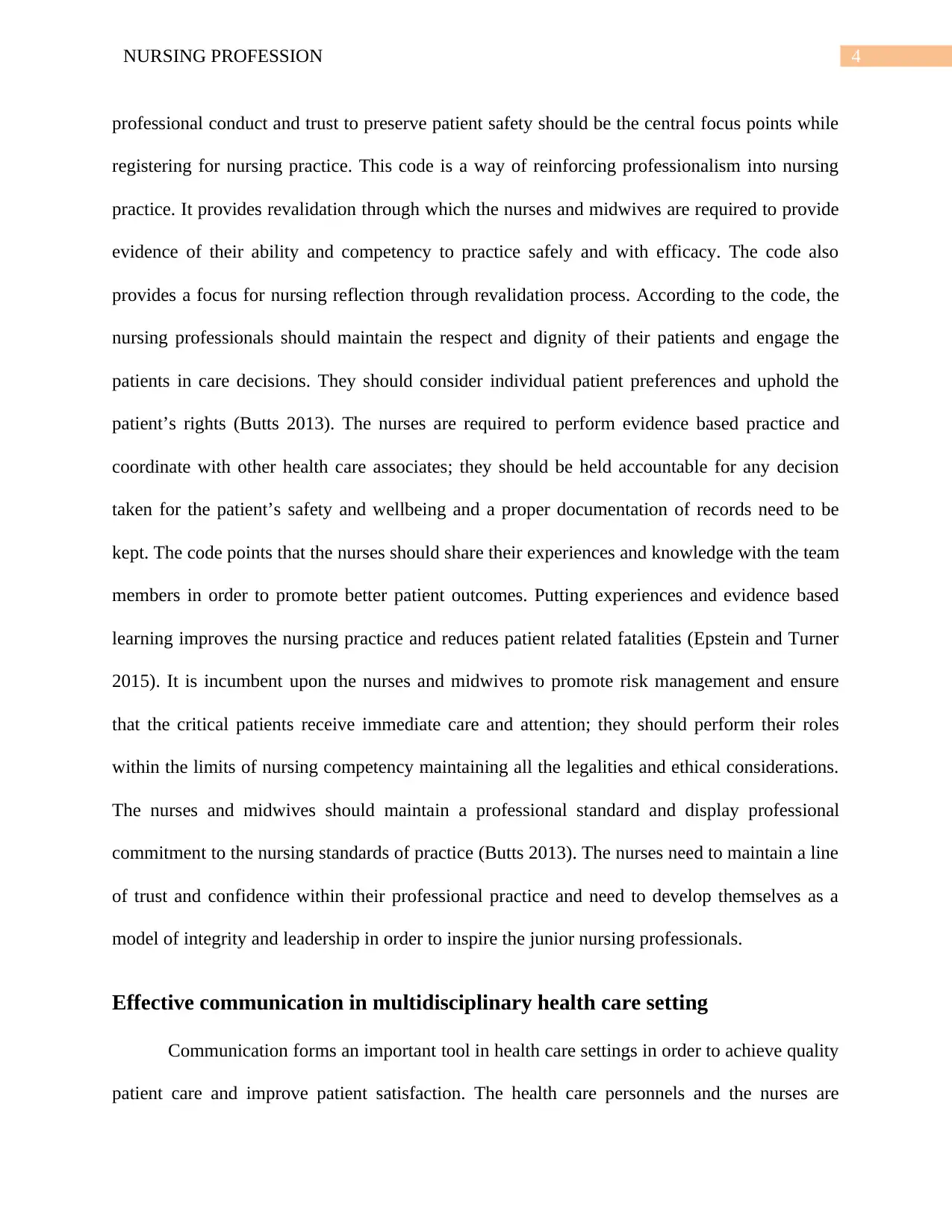
4NURSING PROFESSION
professional conduct and trust to preserve patient safety should be the central focus points while
registering for nursing practice. This code is a way of reinforcing professionalism into nursing
practice. It provides revalidation through which the nurses and midwives are required to provide
evidence of their ability and competency to practice safely and with efficacy. The code also
provides a focus for nursing reflection through revalidation process. According to the code, the
nursing professionals should maintain the respect and dignity of their patients and engage the
patients in care decisions. They should consider individual patient preferences and uphold the
patient’s rights (Butts 2013). The nurses are required to perform evidence based practice and
coordinate with other health care associates; they should be held accountable for any decision
taken for the patient’s safety and wellbeing and a proper documentation of records need to be
kept. The code points that the nurses should share their experiences and knowledge with the team
members in order to promote better patient outcomes. Putting experiences and evidence based
learning improves the nursing practice and reduces patient related fatalities (Epstein and Turner
2015). It is incumbent upon the nurses and midwives to promote risk management and ensure
that the critical patients receive immediate care and attention; they should perform their roles
within the limits of nursing competency maintaining all the legalities and ethical considerations.
The nurses and midwives should maintain a professional standard and display professional
commitment to the nursing standards of practice (Butts 2013). The nurses need to maintain a line
of trust and confidence within their professional practice and need to develop themselves as a
model of integrity and leadership in order to inspire the junior nursing professionals.
Effective communication in multidisciplinary health care setting
Communication forms an important tool in health care settings in order to achieve quality
patient care and improve patient satisfaction. The health care personnels and the nurses are
professional conduct and trust to preserve patient safety should be the central focus points while
registering for nursing practice. This code is a way of reinforcing professionalism into nursing
practice. It provides revalidation through which the nurses and midwives are required to provide
evidence of their ability and competency to practice safely and with efficacy. The code also
provides a focus for nursing reflection through revalidation process. According to the code, the
nursing professionals should maintain the respect and dignity of their patients and engage the
patients in care decisions. They should consider individual patient preferences and uphold the
patient’s rights (Butts 2013). The nurses are required to perform evidence based practice and
coordinate with other health care associates; they should be held accountable for any decision
taken for the patient’s safety and wellbeing and a proper documentation of records need to be
kept. The code points that the nurses should share their experiences and knowledge with the team
members in order to promote better patient outcomes. Putting experiences and evidence based
learning improves the nursing practice and reduces patient related fatalities (Epstein and Turner
2015). It is incumbent upon the nurses and midwives to promote risk management and ensure
that the critical patients receive immediate care and attention; they should perform their roles
within the limits of nursing competency maintaining all the legalities and ethical considerations.
The nurses and midwives should maintain a professional standard and display professional
commitment to the nursing standards of practice (Butts 2013). The nurses need to maintain a line
of trust and confidence within their professional practice and need to develop themselves as a
model of integrity and leadership in order to inspire the junior nursing professionals.
Effective communication in multidisciplinary health care setting
Communication forms an important tool in health care settings in order to achieve quality
patient care and improve patient satisfaction. The health care personnels and the nurses are
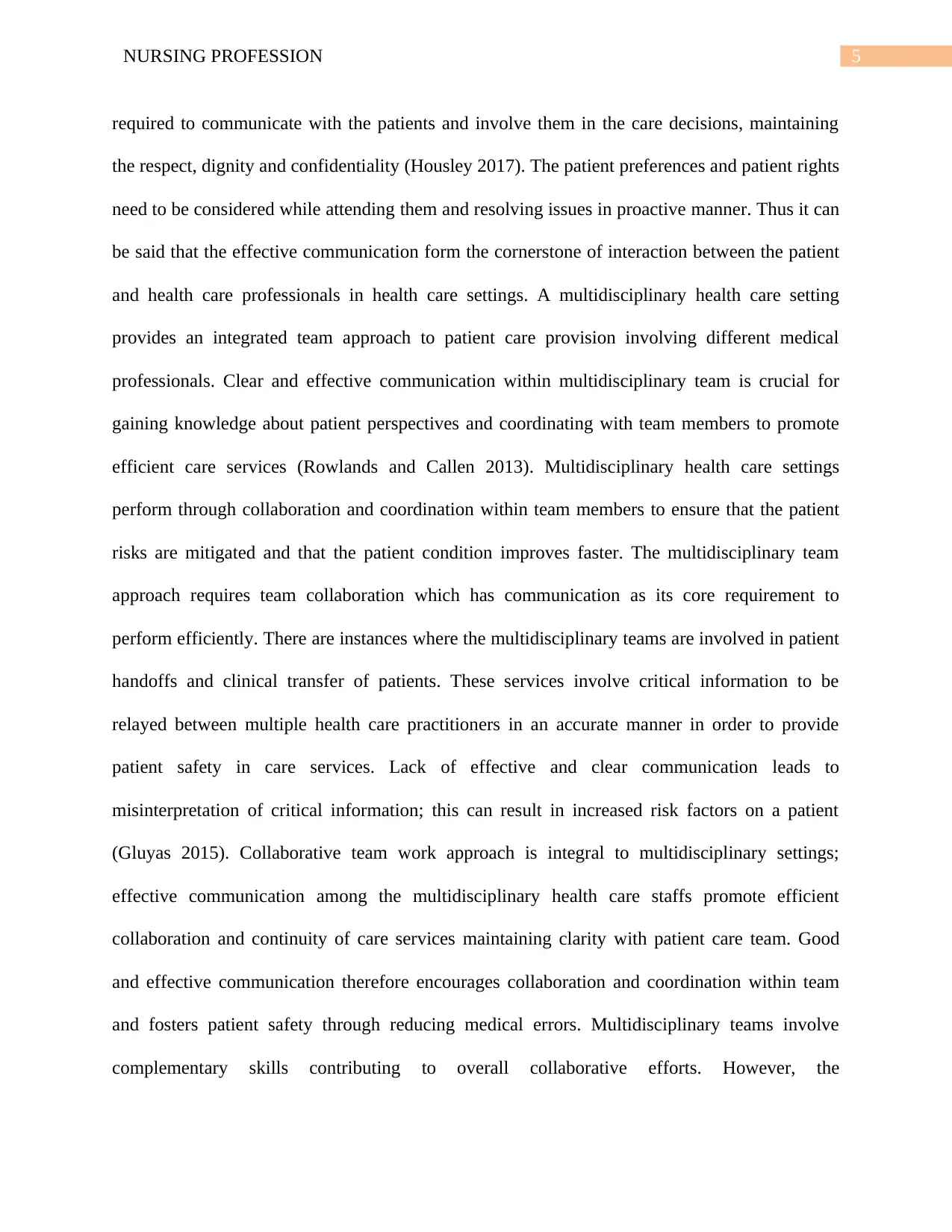
5NURSING PROFESSION
required to communicate with the patients and involve them in the care decisions, maintaining
the respect, dignity and confidentiality (Housley 2017). The patient preferences and patient rights
need to be considered while attending them and resolving issues in proactive manner. Thus it can
be said that the effective communication form the cornerstone of interaction between the patient
and health care professionals in health care settings. A multidisciplinary health care setting
provides an integrated team approach to patient care provision involving different medical
professionals. Clear and effective communication within multidisciplinary team is crucial for
gaining knowledge about patient perspectives and coordinating with team members to promote
efficient care services (Rowlands and Callen 2013). Multidisciplinary health care settings
perform through collaboration and coordination within team members to ensure that the patient
risks are mitigated and that the patient condition improves faster. The multidisciplinary team
approach requires team collaboration which has communication as its core requirement to
perform efficiently. There are instances where the multidisciplinary teams are involved in patient
handoffs and clinical transfer of patients. These services involve critical information to be
relayed between multiple health care practitioners in an accurate manner in order to provide
patient safety in care services. Lack of effective and clear communication leads to
misinterpretation of critical information; this can result in increased risk factors on a patient
(Gluyas 2015). Collaborative team work approach is integral to multidisciplinary settings;
effective communication among the multidisciplinary health care staffs promote efficient
collaboration and continuity of care services maintaining clarity with patient care team. Good
and effective communication therefore encourages collaboration and coordination within team
and fosters patient safety through reducing medical errors. Multidisciplinary teams involve
complementary skills contributing to overall collaborative efforts. However, the
required to communicate with the patients and involve them in the care decisions, maintaining
the respect, dignity and confidentiality (Housley 2017). The patient preferences and patient rights
need to be considered while attending them and resolving issues in proactive manner. Thus it can
be said that the effective communication form the cornerstone of interaction between the patient
and health care professionals in health care settings. A multidisciplinary health care setting
provides an integrated team approach to patient care provision involving different medical
professionals. Clear and effective communication within multidisciplinary team is crucial for
gaining knowledge about patient perspectives and coordinating with team members to promote
efficient care services (Rowlands and Callen 2013). Multidisciplinary health care settings
perform through collaboration and coordination within team members to ensure that the patient
risks are mitigated and that the patient condition improves faster. The multidisciplinary team
approach requires team collaboration which has communication as its core requirement to
perform efficiently. There are instances where the multidisciplinary teams are involved in patient
handoffs and clinical transfer of patients. These services involve critical information to be
relayed between multiple health care practitioners in an accurate manner in order to provide
patient safety in care services. Lack of effective and clear communication leads to
misinterpretation of critical information; this can result in increased risk factors on a patient
(Gluyas 2015). Collaborative team work approach is integral to multidisciplinary settings;
effective communication among the multidisciplinary health care staffs promote efficient
collaboration and continuity of care services maintaining clarity with patient care team. Good
and effective communication therefore encourages collaboration and coordination within team
and fosters patient safety through reducing medical errors. Multidisciplinary teams involve
complementary skills contributing to overall collaborative efforts. However, the
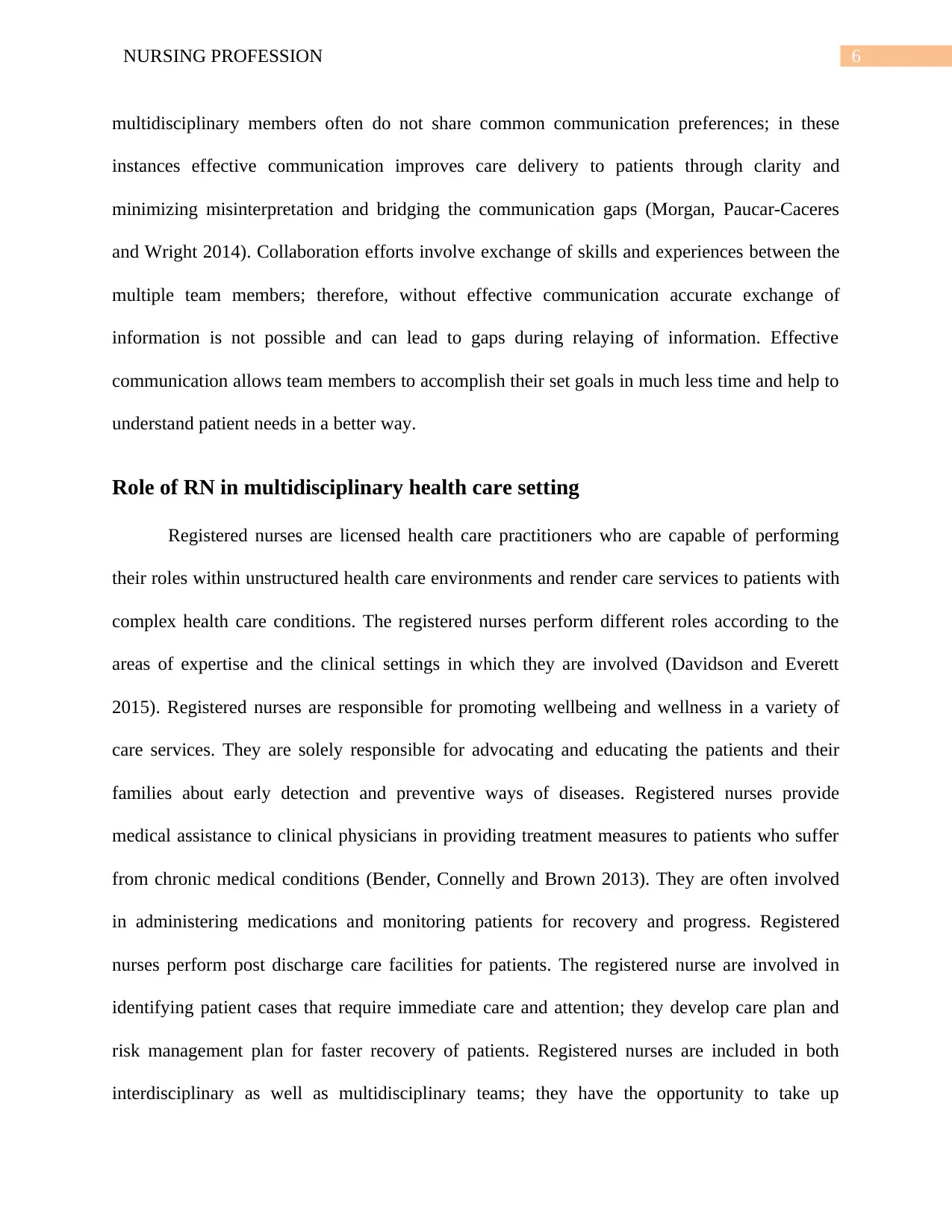
6NURSING PROFESSION
multidisciplinary members often do not share common communication preferences; in these
instances effective communication improves care delivery to patients through clarity and
minimizing misinterpretation and bridging the communication gaps (Morgan, Paucar-Caceres
and Wright 2014). Collaboration efforts involve exchange of skills and experiences between the
multiple team members; therefore, without effective communication accurate exchange of
information is not possible and can lead to gaps during relaying of information. Effective
communication allows team members to accomplish their set goals in much less time and help to
understand patient needs in a better way.
Role of RN in multidisciplinary health care setting
Registered nurses are licensed health care practitioners who are capable of performing
their roles within unstructured health care environments and render care services to patients with
complex health care conditions. The registered nurses perform different roles according to the
areas of expertise and the clinical settings in which they are involved (Davidson and Everett
2015). Registered nurses are responsible for promoting wellbeing and wellness in a variety of
care services. They are solely responsible for advocating and educating the patients and their
families about early detection and preventive ways of diseases. Registered nurses provide
medical assistance to clinical physicians in providing treatment measures to patients who suffer
from chronic medical conditions (Bender, Connelly and Brown 2013). They are often involved
in administering medications and monitoring patients for recovery and progress. Registered
nurses perform post discharge care facilities for patients. The registered nurse are involved in
identifying patient cases that require immediate care and attention; they develop care plan and
risk management plan for faster recovery of patients. Registered nurses are included in both
interdisciplinary as well as multidisciplinary teams; they have the opportunity to take up
multidisciplinary members often do not share common communication preferences; in these
instances effective communication improves care delivery to patients through clarity and
minimizing misinterpretation and bridging the communication gaps (Morgan, Paucar-Caceres
and Wright 2014). Collaboration efforts involve exchange of skills and experiences between the
multiple team members; therefore, without effective communication accurate exchange of
information is not possible and can lead to gaps during relaying of information. Effective
communication allows team members to accomplish their set goals in much less time and help to
understand patient needs in a better way.
Role of RN in multidisciplinary health care setting
Registered nurses are licensed health care practitioners who are capable of performing
their roles within unstructured health care environments and render care services to patients with
complex health care conditions. The registered nurses perform different roles according to the
areas of expertise and the clinical settings in which they are involved (Davidson and Everett
2015). Registered nurses are responsible for promoting wellbeing and wellness in a variety of
care services. They are solely responsible for advocating and educating the patients and their
families about early detection and preventive ways of diseases. Registered nurses provide
medical assistance to clinical physicians in providing treatment measures to patients who suffer
from chronic medical conditions (Bender, Connelly and Brown 2013). They are often involved
in administering medications and monitoring patients for recovery and progress. Registered
nurses perform post discharge care facilities for patients. The registered nurse are involved in
identifying patient cases that require immediate care and attention; they develop care plan and
risk management plan for faster recovery of patients. Registered nurses are included in both
interdisciplinary as well as multidisciplinary teams; they have the opportunity to take up
Paraphrase This Document
Need a fresh take? Get an instant paraphrase of this document with our AI Paraphraser
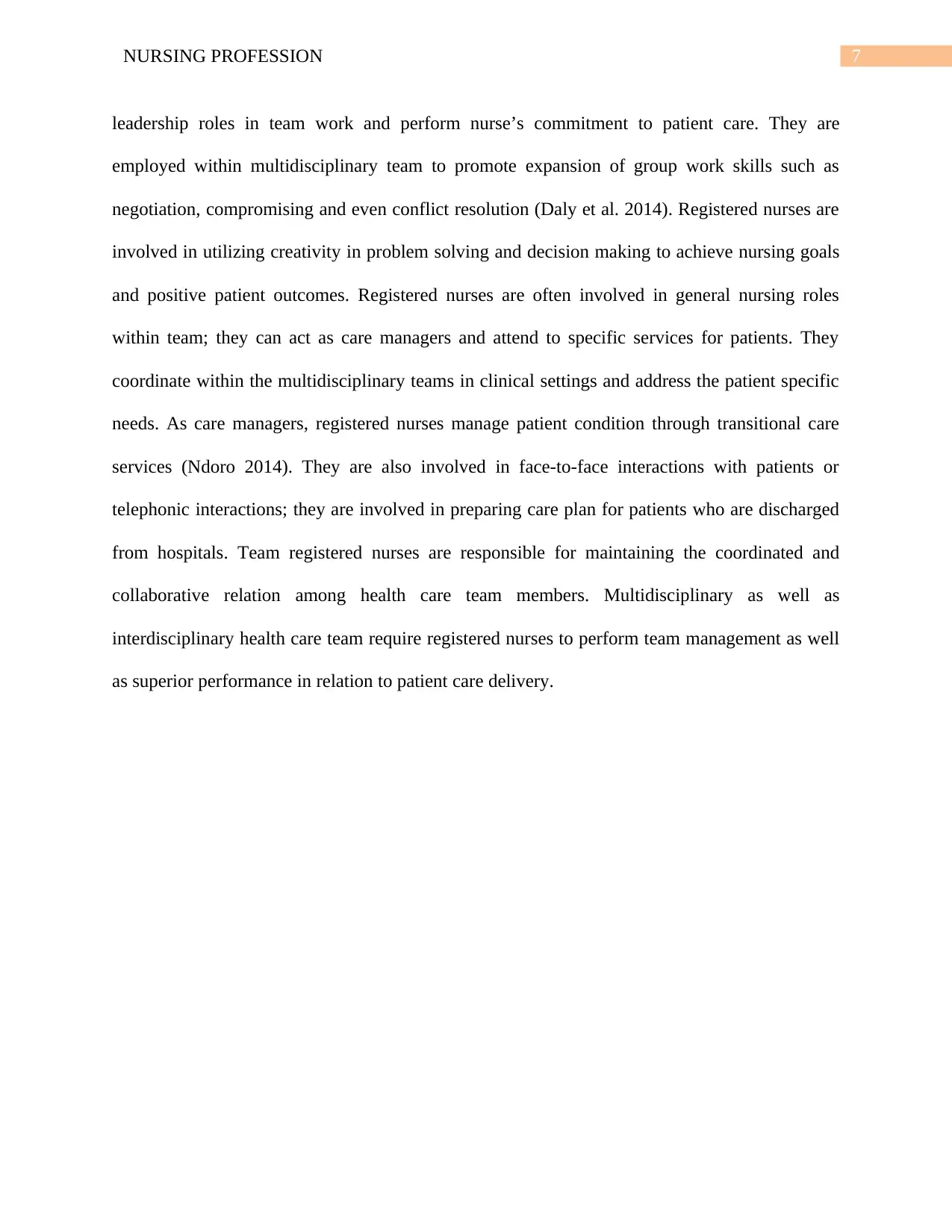
7NURSING PROFESSION
leadership roles in team work and perform nurse’s commitment to patient care. They are
employed within multidisciplinary team to promote expansion of group work skills such as
negotiation, compromising and even conflict resolution (Daly et al. 2014). Registered nurses are
involved in utilizing creativity in problem solving and decision making to achieve nursing goals
and positive patient outcomes. Registered nurses are often involved in general nursing roles
within team; they can act as care managers and attend to specific services for patients. They
coordinate within the multidisciplinary teams in clinical settings and address the patient specific
needs. As care managers, registered nurses manage patient condition through transitional care
services (Ndoro 2014). They are also involved in face-to-face interactions with patients or
telephonic interactions; they are involved in preparing care plan for patients who are discharged
from hospitals. Team registered nurses are responsible for maintaining the coordinated and
collaborative relation among health care team members. Multidisciplinary as well as
interdisciplinary health care team require registered nurses to perform team management as well
as superior performance in relation to patient care delivery.
leadership roles in team work and perform nurse’s commitment to patient care. They are
employed within multidisciplinary team to promote expansion of group work skills such as
negotiation, compromising and even conflict resolution (Daly et al. 2014). Registered nurses are
involved in utilizing creativity in problem solving and decision making to achieve nursing goals
and positive patient outcomes. Registered nurses are often involved in general nursing roles
within team; they can act as care managers and attend to specific services for patients. They
coordinate within the multidisciplinary teams in clinical settings and address the patient specific
needs. As care managers, registered nurses manage patient condition through transitional care
services (Ndoro 2014). They are also involved in face-to-face interactions with patients or
telephonic interactions; they are involved in preparing care plan for patients who are discharged
from hospitals. Team registered nurses are responsible for maintaining the coordinated and
collaborative relation among health care team members. Multidisciplinary as well as
interdisciplinary health care team require registered nurses to perform team management as well
as superior performance in relation to patient care delivery.
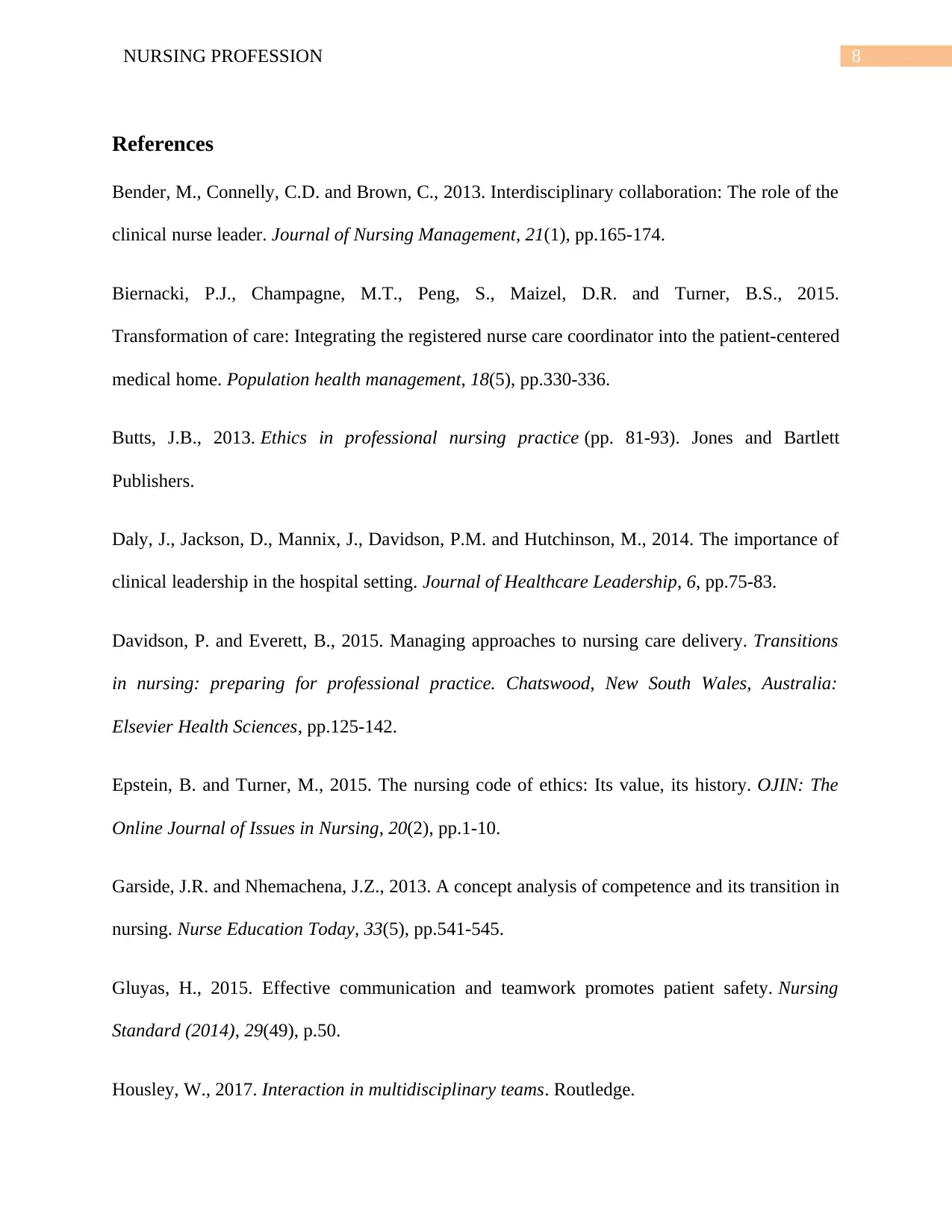
8NURSING PROFESSION
References
Bender, M., Connelly, C.D. and Brown, C., 2013. Interdisciplinary collaboration: The role of the
clinical nurse leader. Journal of Nursing Management, 21(1), pp.165-174.
Biernacki, P.J., Champagne, M.T., Peng, S., Maizel, D.R. and Turner, B.S., 2015.
Transformation of care: Integrating the registered nurse care coordinator into the patient-centered
medical home. Population health management, 18(5), pp.330-336.
Butts, J.B., 2013. Ethics in professional nursing practice (pp. 81-93). Jones and Bartlett
Publishers.
Daly, J., Jackson, D., Mannix, J., Davidson, P.M. and Hutchinson, M., 2014. The importance of
clinical leadership in the hospital setting. Journal of Healthcare Leadership, 6, pp.75-83.
Davidson, P. and Everett, B., 2015. Managing approaches to nursing care delivery. Transitions
in nursing: preparing for professional practice. Chatswood, New South Wales, Australia:
Elsevier Health Sciences, pp.125-142.
Epstein, B. and Turner, M., 2015. The nursing code of ethics: Its value, its history. OJIN: The
Online Journal of Issues in Nursing, 20(2), pp.1-10.
Garside, J.R. and Nhemachena, J.Z., 2013. A concept analysis of competence and its transition in
nursing. Nurse Education Today, 33(5), pp.541-545.
Gluyas, H., 2015. Effective communication and teamwork promotes patient safety. Nursing
Standard (2014), 29(49), p.50.
Housley, W., 2017. Interaction in multidisciplinary teams. Routledge.
References
Bender, M., Connelly, C.D. and Brown, C., 2013. Interdisciplinary collaboration: The role of the
clinical nurse leader. Journal of Nursing Management, 21(1), pp.165-174.
Biernacki, P.J., Champagne, M.T., Peng, S., Maizel, D.R. and Turner, B.S., 2015.
Transformation of care: Integrating the registered nurse care coordinator into the patient-centered
medical home. Population health management, 18(5), pp.330-336.
Butts, J.B., 2013. Ethics in professional nursing practice (pp. 81-93). Jones and Bartlett
Publishers.
Daly, J., Jackson, D., Mannix, J., Davidson, P.M. and Hutchinson, M., 2014. The importance of
clinical leadership in the hospital setting. Journal of Healthcare Leadership, 6, pp.75-83.
Davidson, P. and Everett, B., 2015. Managing approaches to nursing care delivery. Transitions
in nursing: preparing for professional practice. Chatswood, New South Wales, Australia:
Elsevier Health Sciences, pp.125-142.
Epstein, B. and Turner, M., 2015. The nursing code of ethics: Its value, its history. OJIN: The
Online Journal of Issues in Nursing, 20(2), pp.1-10.
Garside, J.R. and Nhemachena, J.Z., 2013. A concept analysis of competence and its transition in
nursing. Nurse Education Today, 33(5), pp.541-545.
Gluyas, H., 2015. Effective communication and teamwork promotes patient safety. Nursing
Standard (2014), 29(49), p.50.
Housley, W., 2017. Interaction in multidisciplinary teams. Routledge.
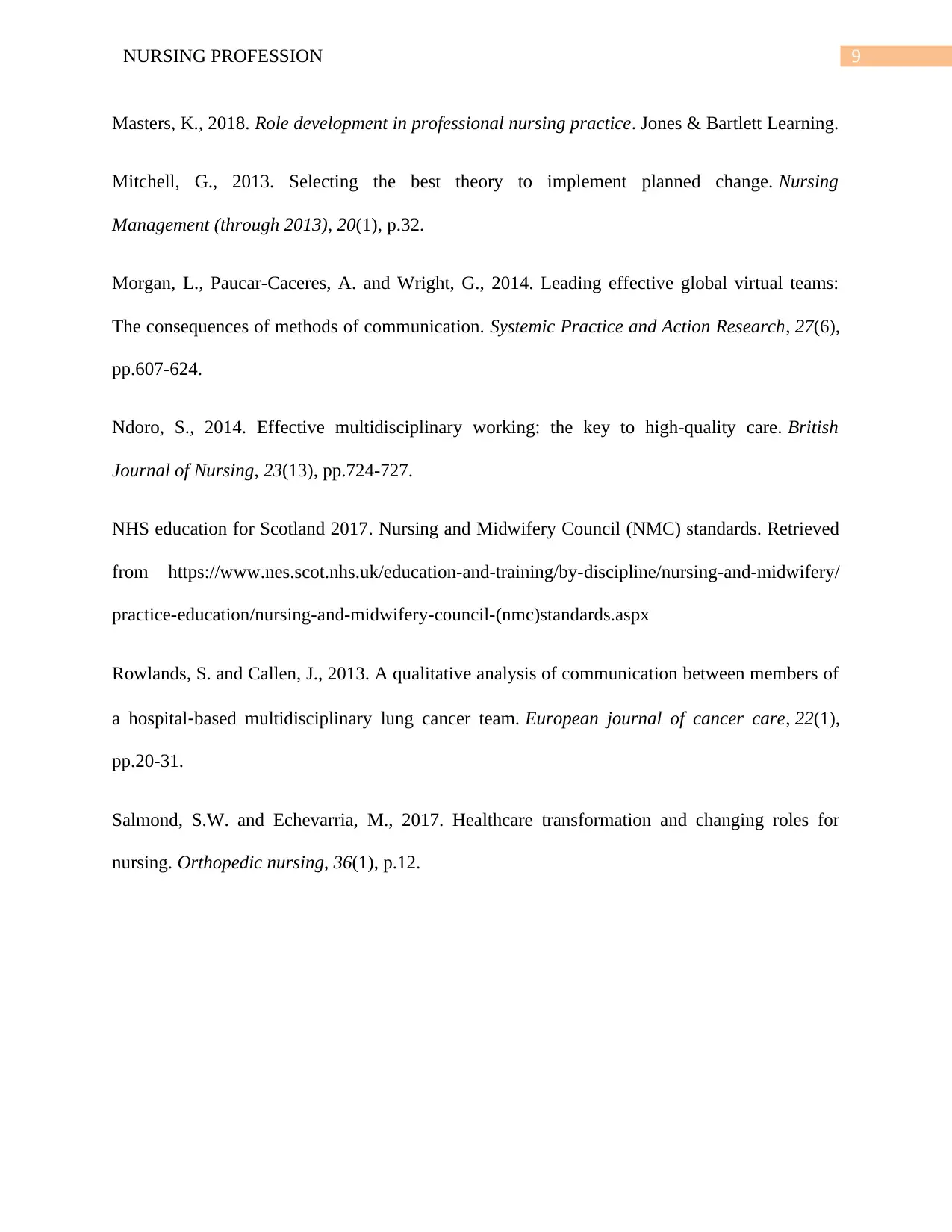
9NURSING PROFESSION
Masters, K., 2018. Role development in professional nursing practice. Jones & Bartlett Learning.
Mitchell, G., 2013. Selecting the best theory to implement planned change. Nursing
Management (through 2013), 20(1), p.32.
Morgan, L., Paucar-Caceres, A. and Wright, G., 2014. Leading effective global virtual teams:
The consequences of methods of communication. Systemic Practice and Action Research, 27(6),
pp.607-624.
Ndoro, S., 2014. Effective multidisciplinary working: the key to high-quality care. British
Journal of Nursing, 23(13), pp.724-727.
NHS education for Scotland 2017. Nursing and Midwifery Council (NMC) standards. Retrieved
from https://www.nes.scot.nhs.uk/education-and-training/by-discipline/nursing-and-midwifery/
practice-education/nursing-and-midwifery-council-(nmc)standards.aspx
Rowlands, S. and Callen, J., 2013. A qualitative analysis of communication between members of
a hospital‐based multidisciplinary lung cancer team. European journal of cancer care, 22(1),
pp.20-31.
Salmond, S.W. and Echevarria, M., 2017. Healthcare transformation and changing roles for
nursing. Orthopedic nursing, 36(1), p.12.
Masters, K., 2018. Role development in professional nursing practice. Jones & Bartlett Learning.
Mitchell, G., 2013. Selecting the best theory to implement planned change. Nursing
Management (through 2013), 20(1), p.32.
Morgan, L., Paucar-Caceres, A. and Wright, G., 2014. Leading effective global virtual teams:
The consequences of methods of communication. Systemic Practice and Action Research, 27(6),
pp.607-624.
Ndoro, S., 2014. Effective multidisciplinary working: the key to high-quality care. British
Journal of Nursing, 23(13), pp.724-727.
NHS education for Scotland 2017. Nursing and Midwifery Council (NMC) standards. Retrieved
from https://www.nes.scot.nhs.uk/education-and-training/by-discipline/nursing-and-midwifery/
practice-education/nursing-and-midwifery-council-(nmc)standards.aspx
Rowlands, S. and Callen, J., 2013. A qualitative analysis of communication between members of
a hospital‐based multidisciplinary lung cancer team. European journal of cancer care, 22(1),
pp.20-31.
Salmond, S.W. and Echevarria, M., 2017. Healthcare transformation and changing roles for
nursing. Orthopedic nursing, 36(1), p.12.
1 out of 10
Related Documents
Your All-in-One AI-Powered Toolkit for Academic Success.
+13062052269
info@desklib.com
Available 24*7 on WhatsApp / Email
![[object Object]](/_next/static/media/star-bottom.7253800d.svg)
Unlock your academic potential
© 2024 | Zucol Services PVT LTD | All rights reserved.




